-
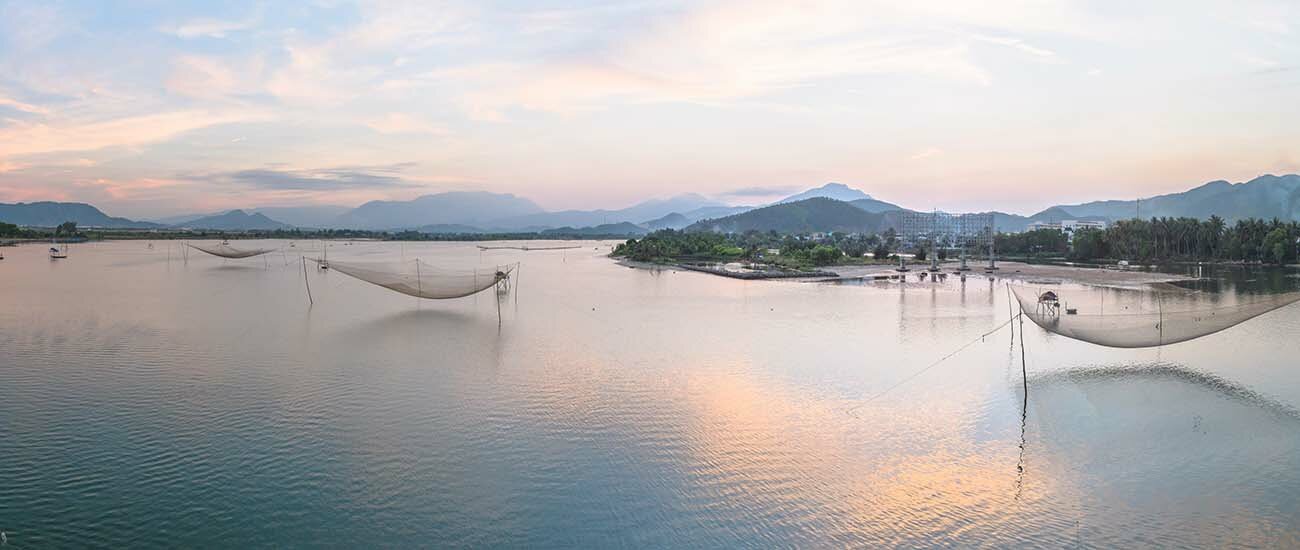 Danang, Vietnam © Christopher Crouzet/Flickr/CC BY 2.0
Danang, Vietnam © Christopher Crouzet/Flickr/CC BY 2.0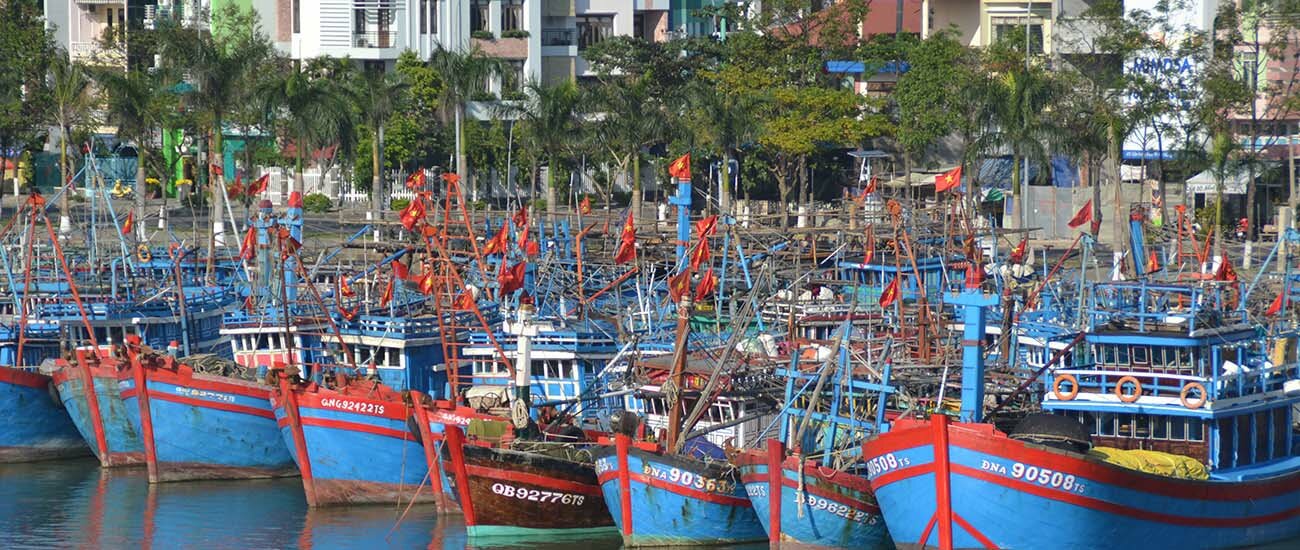 Danang, Vietnam © Loi Nguyen Duc/Flickr/CC BY 2.0
Danang, Vietnam © Loi Nguyen Duc/Flickr/CC BY 2.0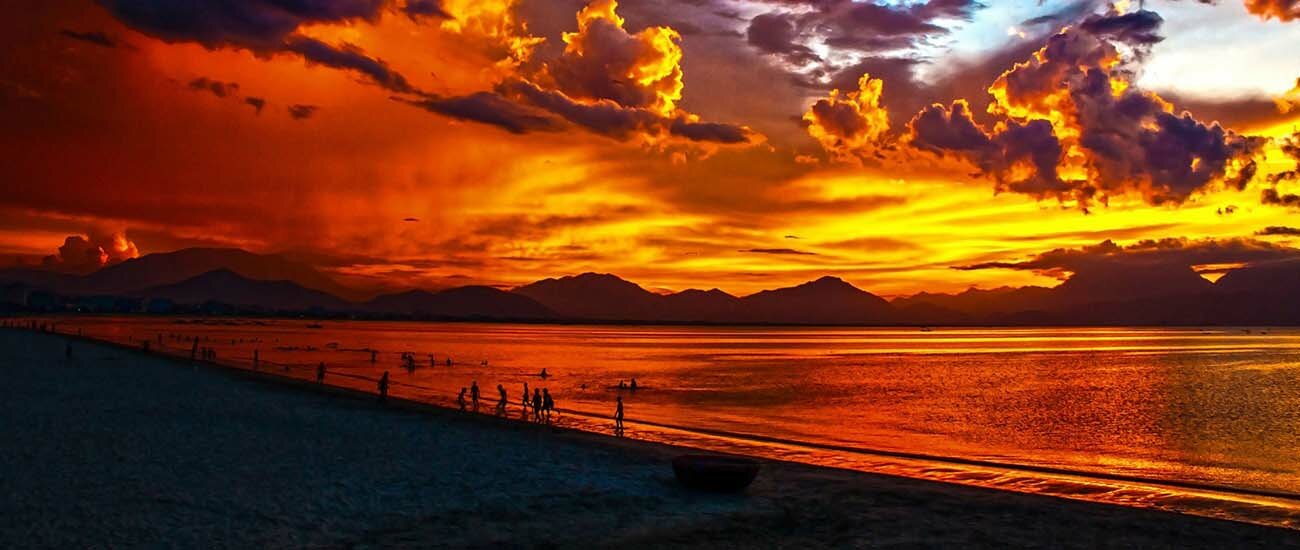 Danang, Vietnam
Danang, Vietnam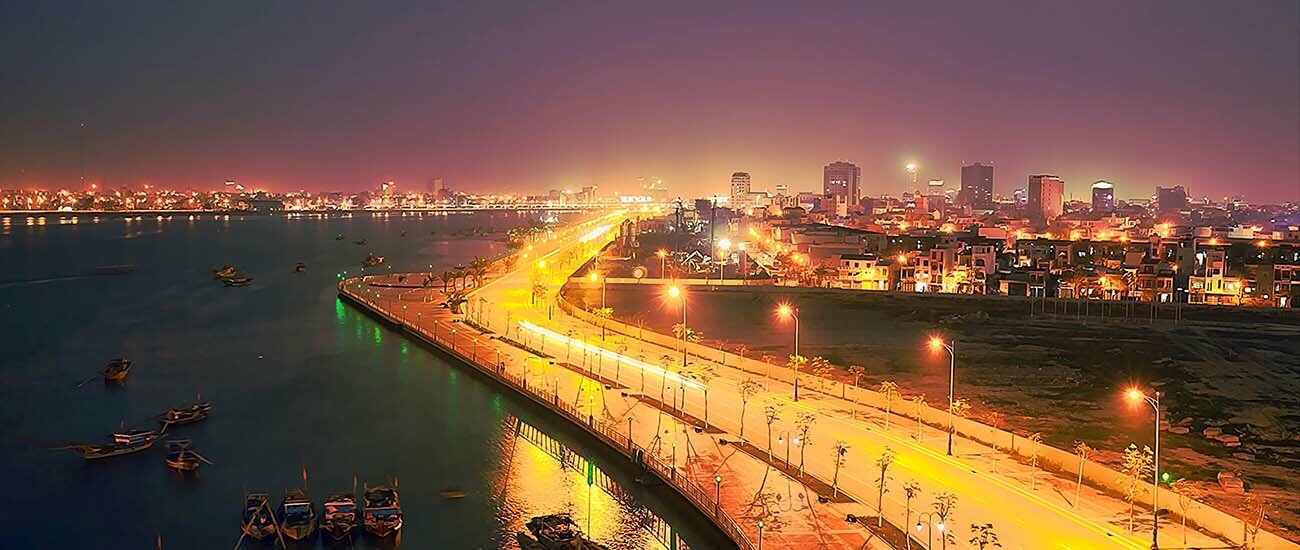 Danang, Vietnam
Danang, Vietnam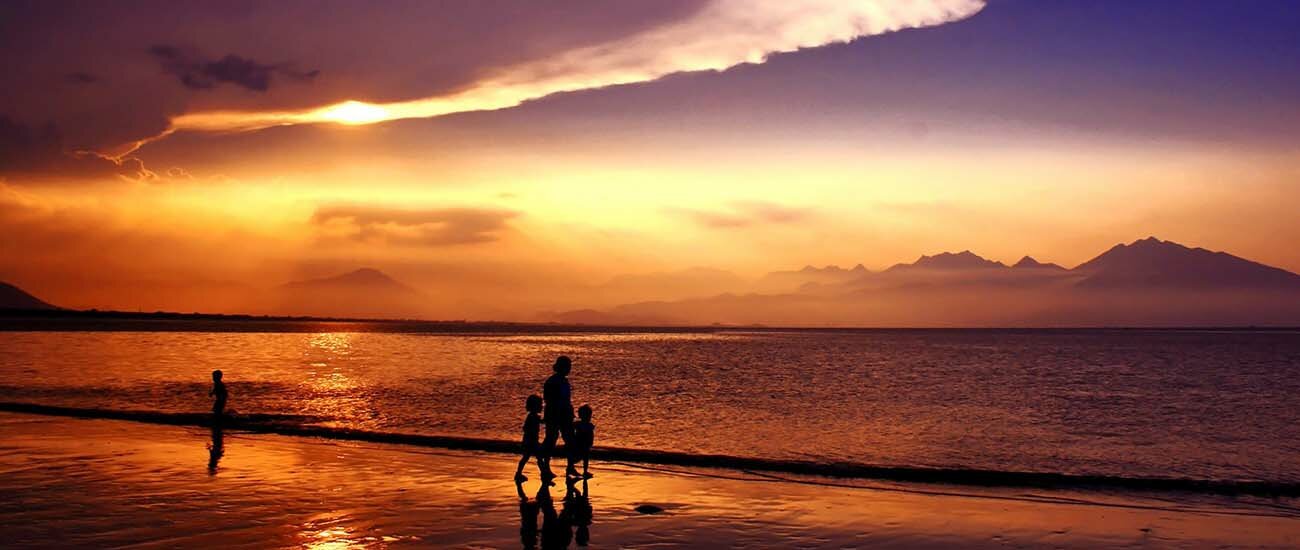 Danang, Vietnam
Danang, Vietnam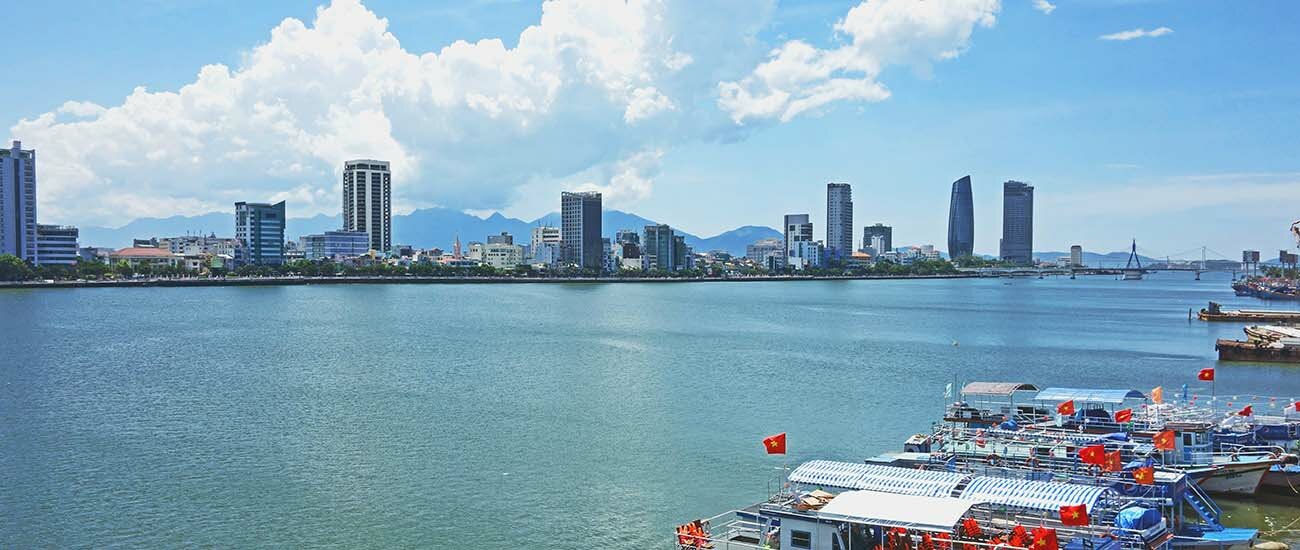 Danang, VietnamNearby:
Danang, VietnamNearby:Danang, Vietnam
Da Nang (Đà Nẵng) is Vietnam's fourth or fifth largest city, and is on the South China Sea coast, midway between Hanoi and Ho Chi Minh City and the largest city of Central Vietnam.
The city itself has neither the ambiance of Hanoi nor the hustle-bustle of Ho Chi Minh City, but has its share of sights and is close to the charms of Hoi An and the imperial capital of Hue, making it a popular vacation spot for those looking to explore the attractions of central Vietnam or soak up some sun while hanging out on the city's beaches.The regions surrounding Da Nang (My Son, Quang Nam) were founded by the Cham Hindus most possibly 3,000 years ago, serving as the capital... Read more
Destination:Danang, VietnamDa Nang (Đà Nẵng) is Vietnam's fourth or fifth largest city, and is on the South China Sea coast, midway between Hanoi and Ho Chi Minh City and the largest city of Central Vietnam.
The city itself has neither the ambiance of Hanoi nor the hustle-bustle of Ho Chi Minh City, but has its share of sights and is close to the charms of Hoi An and the imperial capital of Hue, making it a popular vacation spot for those looking to explore the attractions of central Vietnam or soak up some sun while hanging out on the city's beaches.The regions surrounding Da Nang (My Son, Quang Nam) were founded by the Cham Hindus most possibly 3,000 years ago, serving as the capital city and center of the Hindu Champa Dynasty. Vietnamese invasions into the region in the 17th century significantly halted Cham development.
Given that Da Nang was the first point of colonial invasion, many vestiges of French architecture are present in the historic buildings.
There are many remnants of the "American War" leftover in Da Nang. During the war, many monuments and buildings were destroyed. On the way to the popular tourist spot; China Beach, the ruins of a military base remain in the form of helicopter hangars, although these are now more easily spotted at the airport, which serves both civil and military flights.
The city is often overlooked by tourists but is one of the friendliest to backpackers in all of Vietnam. My Khe Beach, known to American GIs as China Beach, is now home to a small community of guesthouse owners, marble statue shops, and other various trades. Some of the most beautiful and isolated beaches in Vietnam are found here, among some of the friendliest people. This is a must-stop for the budget traveler.
Until relatively recently, Da Nang was somewhat hostile to foreigners, a consequence of the attitudes of those who controlled the provincial government. In the early 1990s, however, this changed, and since then the provincial (actually autonomous city) government has been enthusiastically pursuing foreign investment and infrastructure development. Da Nang has some of the best roads in the country. The coast road is at least four lanes from northern provincial boundary to southern provincial boundary. Compared to either Hanoi or HCMC, traffic in Da Nang is always relatively light, although huge trucks blast through every now and again and there are brief rush hours.
The city has grown rapidly in recent years. Until recently, this growth was mostly outward and infill, but now there are high-rises going up. Development is visible and rapid; the city has expanded tremendously in the last ten years, and several multi-story buildings, as well as more beach resorts, are under construction, and there are now at least three large supermarkets as well as a Metro wholesaler. This involves the redevelopment of areas near the city beaches across the river, with whole blocks of old housing being razed, new roads paved, and luxurious villas constructed.
The downside to the very laid back, less serious and frenetic aspect of Da Nang is that even locals frequently complain that there is nothing to do except drink, which they do a lot. This is not really true. There is a zoo, a soccer stadium, many tennis courts, and pool halls, several large modern discos/night clubs, etc., and of course the beaches and Son Tra Peninsula. However, it is also true that coffee and beer drinking is the most common leisure activities of most local residents.
The hottest months of the year are Jun-Aug when the temperature can get to as high as 40 degrees Celsius, and it is generally very dry. There are usually tropical storms in Oct-Nov.
Source:https://en.wikivoyage.org/wiki/Da_Nang
Text is available under Creative Commons Attribution-ShareAlike 3.0Danang, Vietnam: Port Information
Cruise ships dock at the port of Tien Sa. To get to Da Nang, you can take a taxi or a bus. The ride on a bus will last around 30 minutes. Taxi is faster than a bus, but be sure to reach an agreement with taxi drivers before the ride.
You can find a taxi in the main exit from the harbor, which is around 0.3 miles from the pier.
There is nothing to do at the port; the area is industrial.Get around Danang, Vietnam
By taxi
Taxi rates are very reasonable in Da Nang, and scams are less common than in Hanoi or Ho Chi Minh City, but you're better off going with a reputable company to avoid any hassle. Mai Linh (mostly green with white lettering, though sometimes green or silver) ☎ +84 511 356 5656 (or 0511 356 5656 if dialing from a local telephone) and Vinasun (white with green and red lettering) ☎ +84 511 368 6868 have large fleets in the city and are generally honest and reliable, with meters that start automatically after the taxis have moved about 5m. At the airport, Mai Linh taxi wardens wear green shirts with green ties and Vinasun wardens dark green shirts with maroon ties. These wardens can radio taxis for you. Some travelers have reported that Song Han's yellow taxis are also fairly reliable.
By bus
Da Nang has limited bus service inside the city but has a fairly reliable (though not so comfortable) intercity bus to Hoi An.
If you want to catch the bus from the train station, you can walk out of the station straight to the next big street (Le Duan St, in front of #287, less than 5 min walk. Bus goes eastwards, to the left). You should be able to see the bus stop for a yellow colored Bus 1, Da Nang - Hoi An on the opposite side of the road. You may have to insist on that fare as the conductor will probably try to charge more (for luggage or because you are a foreigner). This same bus also passes by Marble Mountain (Vietnamese: Non Nước or Ngũ Hành Sơn). Bus 4 (destination Tam Ky) leaves from the same location (Le Duan Bus 287) and goes to Hoi An as well but stops at a more central place in Hoi An.
Note that taxi drivers may park in front of the bus stop and tell you that the bus is not running. This is not true; they're just trying to get your business.By motorbike
The distance to Hoi An is approximately 28 km and takes about 45–60 min. The route is fairly simple and straightforward and takes you along the coastline of Da Nang allowing you an extraordinary experience and views along the beaches to Hoi An. The traffic is light. Make sure you bring along a windbreaker or sweater as during autumn and spring as the temperature along the coastline can be a little cold. Avoid riding in the winter season as the wind is strong and rain is frequent.
What to see in Danang, Vietnam
For years, tourists have bypassed Da Nang on their travel itineraries, preferring to spend their time viewing the ancient imperial court at Hue or walking the streets of the old town inHoi An
. And yet, as those who call it home are aware, Da Nang has plenty of interesting and beautiful sights of its own. Nestled in between the Annamite Range and the South China Sea on the banks of the Han River, Da Nang's natural beauty is hard to miss; a trip up into the mountains and down to the beach should be on your to-do list. Culturally, Da Nang once lay at the northernmost reaches of the Kingdom of Champa; theMuseum of Cham Sculpture
, located downtown, should be mandatory if you're planning on visiting the ruins at nearby My Son.- Ba Na Hill Station (About 40km W of Da Nang). Ba Na is 1,487 m above sea level in the Truong Son Mountains. It was formerly a 1920s French resort and once boasted 200 villas, restaurants, and clubs. It is known as the second Dalat or Sa Pa in central Vietnam. Its temperate climate, unspoiled forest, and spectacular views over the South China Sea and the Lao mountains made Ba Na a popular retreat for both the French and the wealthy Vietnamese. Today the area still attracts locals and tourists alike thanks to a new cable car system that was officially opened in 2009 and set two Guinness World Records for its height and length. Great view from the top but it's really useless to stay overnight since the accommodations are shabby and terribly overpriced.
-
Han River Promenade, along Bach Dang Rd (Between Dragon Bridge and Danang Port). The beauty of the Han River has inspired poets and composers throughout Da Nang's history, and any local will probably be able to sing you a few lines of Sông Hàn Tình Yêu Của Tôi (Han River, My Love) as they stroll the edge of the water. The promenade on the western bank of the river is well built up, stretching from the Dragon Bridge in the south to the city port in the north. The promenade passes underneath the iconic
Han River Bridge
, a swing bridge built in the late '90s, one of four bridges across the Han you can glimpse from here (the others are the Thuan Phuoc, Dragon, and Tran Thi Ly bridges). All of the bridges light up with colorful patterns at night, making a walk by the river a delightful (and certainly romantic) escapade. Locals often gather here in the evenings to watch the water, play hacky-sack, or bring their children for a run. During the Tet season, the promenade is festooned with sculptures and art. The annual Fireworks Festival is also based here, but you're better off seeing the show from afar, as it tends to get quite crowded. - Linh Ung Temple, Hoang Sa Rd (Bai But, Son Tra Peninsula). Stunning views of the sea, the sky, and a 67 m tall statue of "Quan The Am" facing the ocean. The pagoda was built in 2010.
- Marble Mountains (Ngu Hanh Son) (9km S of downtown and across the street from many of the larger beach side resorts), ☎ +84 511 961114. The group includes Kim Son (Mountain of Metal), Moc Son (Mountain of Wood), Thuy Son (Mountain of Water), Hoa Son (Mountain of Fire), and Tho Son (Mountain of Earth). Several Buddhist temples have been built into the caves and grottoes, and it's a popular pilgrimage site. The real fun, though, is at the Am Phu cave, where you can make the steep climb up toward the light and a view from the top of the mountain, surrounded by approving sacred images; or head in the opposite direction, physically and spiritually, down to the crude Hieronymous Bosch-esque statues of sinners getting their due in the caverns below, with appropriately eerie lighting. Either way, wear walking or climbing shoes. Open-tour buses will stop here, but you'll be rushed along; any motorbike taxi in Da Nang or Hoi An will be happy to take you and let you set the schedule. Guides are available. Watch out for the rapacious statue-sellers outside.
- Museum of Cham Sculpture (Bảo Tàng Chăm), #2, September 2nd Rd (Near the roundabout at the corner of Trung Nu Vuong and Bach Dang St). Founded in 1915 by the École Française d'Extrême Orient, it houses a collection of stone sculptures from the Hindu-practicing Cham civilization, which occupied much of central Vietnam in the first millennium CE through about the 14th century. The museum can be toured in about an hour. The sculptures are nearly all made of sandstone, and some have weathered badly over the centuries, but you can still appreciate the delightful artistic quality of the figures, which include shiva, garudas, nagas, lions, monkeys, and elephants. The collection also includes striking examples of the ancient Hindu icons of fertility: lingam altars decorated around the sides with rows of breasts. The sculptures were mostly removed from the facades or interiors of Cham ruins (which would have been looted otherwise.) The ruins themselves, such as nearby My Son, now tend to be crumbling piles of bricks and somewhat disappointing, giving little sense of the spectacular artwork produced by the Cham civilization. Any visit to My Son should be paired with a visit to the Cham Museum. The collection is also interesting to compare with Balinese sculpture and the early, Hindu phase of Angkor Wat in Cambodia.
What to do in Danang, Vietnam
- Cham Island Tour, ☎ +84 510 8505605. Transfer to Cua Dai beach harbor by an air-con bus. Cruises to the Cham Islands board at 08:00, traveling by wooden boat for 1 1/4 hours or by speed boat for 30 minutes. On arrival, there are visits to Hai Tang Pagoda, the boat shelter, a local market at Bai Lang, then cruise to Bai Chong for swimming and snorkeling to see the coral reef before having lunch at a local restaurant on the island. Relax for a while after lunch and get ready for cruising back to Cua Dai Beach harbor. Departure is at 15:00.
- Motorbike ride up Monkey Mountain (Son Tra Mountain) (Follow Hoang Sa Rd. towards the mountain). If you feel like a ride with an amazing view, rent a motorbike and make your way up the side of Monkey Mountain (aka Son Tra Mountain), where an American army base was once located. Although access to the base is closed off, you can still follow Hoang Sa Rd. for a good distance and enjoy getting lost in the beautiful scenery on this road that hugs the mountainside while offering an expansive view of the Pacific Ocean. You can also stop off at Linh Ung Temple along the way, both to pay your respects to Quan The Am and to enjoy the wonderful view.
- My Khe Beach (China Beach), Hoang Sa Rd. Across the Han River from downtown, My Khe Beach—the northern edge of the fabled "China Beach"—is a wide, sandy beach long known for its beauty. Locals will often gather here as early in the morning at 05:00 to enjoy the surf while the sun rises over the ocean. Tourists often arrive later on, when the locals have already started their day; you'll probably find that by 09:00 or 10:00 the beach is mostly deserted. The beach isn't steep, meaning that you can swim far out and still feel your feet touch the bottom. During busy times, lifeguards float around in coracle boats, whistling at those who venture too far out. In the distance on Monkey Mountain, you can make out the giant statue of "Quan The Am" at Linh Ung Temple. There are change rooms and public showers you can use as you enter and leave the water, as well as motorbike parking for a small fee.
- Ride a motorbike up the Hai Van Pass (Hai Van Pass) (Follow the coast road N until you reach Rd 1A). The Hai Van Pass is a great day trip from Da Nang (or Hoi An). The road was called "a deserted ribbon of perfection—one of the best coast roads in the world" in the BBC show Top Gear. Since the tunnel opened, most heavy traffic has diverted from the pass, making the ride much safer, and you'll only meet a few trucks ferrying live animals or dangerous goods, plus quite a few motorbikers coming to enjoy the views. Make sure you ride down the north side of the pass all the way to Lang Co and enjoy the view of the lagoon set against a background of mountains. Make sure you fill up your tank before hitting the pass (there's a petrol station a few kilometers before the road starts climbing) as you won't find petrol there.
What to eat and drink in Danang, Vietnam
Eat
Although not a culinary capital like the ancient imperial capital Hue, Da Nang still has more than enough variety to keep you well fed throughout your stay. Seafood (hải sản) is big here, so you shouldn't be surprised to see plenty of it—fish (cá), shrimp (tôm), squid (mực), clams (nghêu), snails (ốc), and the list goes on. As long as it looks fresh and well-cooked, give it a try.
Then there are regional specialties like mì Quảng, or Quang Nam-style noodles, featuring chicken, shrimp, quail eggs, peanuts and rice crackers in a turmeric-spiced broth; bún chả cá, or rice vermicelli with fish sausage; and bún mắm, or rice vermicelli served with a high-octane fish sauce that's not for the weak of palate. Central Vietnamese love their food spicy, too, so be warned that the chili peppers (ớt) you may see on your table are the real thing, even if they look tiny and harmless.Budget
- Bánh Mì̀ Bà Lan, 62 Trưng Nữ Vương, Bình Hiên, Hải Châu, ☎ +84 93 564 62 86. 16:00-19:00. One of the most famous sandwich carts in the city. Try their bánh mì que which is a string baguette filled with a pork pâté.
- Quán Thảo, 135, Dương Trí Trạch, An Hải Bắc, Sơn Trà (Take Phạm Văn Đồng (heading towards the beach), left on Lê Minh Trung, right on Morrison and a quick left on to Trí Trạch. Quán Thảo is on the right.). 06:00-10:00. Traditional street food establishment frequented mostly by locals for breakfast, on a quiet side road. While Ms Thảo serves Mì Quảng or [Province of] Quảng style noodles, she's known for her bún bò or beef noodle soup.
- Quán Dung Mỳ Quảng, 99 Nguyễn Thị Định, An Hải Bắc, Q. Sơn, ☎ +84 122 727 4421 (mobile). 06:00-21:00. Well known for their mì quảng cá lóc, the best known noodle dish of Đà Nẵng, served with broad rice noodles, fresh greens, a broth seasoned with turmeric, shallots and garlic topped and with peanuts. It is served in a shallow and pungent pool of broth unlike its better known cousin phở, which is milder and fills the bowl. Cá lóc is snakehead fish; when prepared correctly, which this place is known for, has a mild flavor and very light texture. Take some of the fresh greens and stir them into the broth to give them a bit of warmth and flavor making this dish half salad and half soup. Menu with prices are on the wall. As the restaurant faces west, if you go around sunset, you'll have a pleasant view. Plenty of parking. The cleanliness of Quán Dung Mỳ Quảng is to Western restaurant standards.
- Bún Mắm Vân, 23/14 Trần Kế Xương, Hải Châu 2, Hải Châu, ☎ +84 236 3818 009. 13:00-20:00. Bún mắm is an extremely pungent noodle dish made with a fermented fish sauce called mắm nêm. Mắm nêm can best be described as "smells like hell, tastes like heaven." Bún Mắm Vân is located in what is called "Bún Mắm Alley" where a few bún mắm shops have congregated. You can smell this alley from a block away. Try the bún mắm thịt quay or bún mắm with roasted pork. If you are put off by the smell of strong fish sauce this is not the place for you. If you like bún mắm this place is heaven.
- Mi Quang 1A, 1 Hải Phòng, Hải Châu 1, Q. Hải Châu (Take Lê Duẩn heading east, turn left onto Nguyễn Thị Minh Khai, first right onto Hải Phòng. On the right.), ☎ +84 236 3827 936. 06:30-21:00. Mi Quang 1A is one of the best known mì quảng restaurants in the area. While still good it has lost a bit of its luster over the years. Make sure you are in Mi Quang 1A as there is a "copycat" place next door. Before going in grab a fresh sugarcane juice from the cart in the front.
- Kem Ý Sasa Gelano (Coffee SaSa Gelato), Lô 9 A2 Khu Biệt Thự Đảo Xanh, Quận Hải Châu (Head east on Cầu Trần Thị Lý towards the "sail bridge", take the first right after the roundabout nearest the bridge and then an immediate left. Follow the road for about 350 m turning right at the fork.), ☎ +84 0946 059 339. 0800-2200. A good place to satisfy your sweet tooth. Choose from many local fruit flavors and the regulars, like chocolate. Sa Sa also serves sundaes and other treats to enjoy. Good for families. Take away available. The staff speaks basic English.
Mid-range
- Bao Nam Tran, 27 Nguyen Chi Thanh St (Between Nguyen Du and Ly Thuong Kiet). Private, popular place for coffee, business dealings, meals, and light Vietnamese pastries, drinks and desserts. The restaurant/coffee house's ancient Vietnamese architecture incorporates heavy, dark, ornate wooden panels and furniture mixed with modern amenities (escalator) and is a must-see. Wireless Internet connection and a selection of reading material are available.
- Com Nieu Nha Do, 176 Nguyễn Tri Phương (Across from March 29 (29/3) Park), ☎ +84 511 3990086. 10:00-22:00. Cơm niêu is a type of rice that's baked in a clay pot and served with any number of sides — beef, chicken, fish, hot pot — but it's the way it's served that catches your attention. Waiters come out of the kitchen bearing hot clay pots straight out of the oven, pull out hammers, smash them at your table, and fling the crusty, baked rice inside back and forth across the room. Otherwise, the food is what you'd get at a normal restaurant, but it's fun to see the show. Located near the airport, just across from March 29 Park. There are many of these restaurants on Nguyen Tri Phuong St, but this one is a favorite.
- Karma Waters, 113/10 Nguyen Chi Thanh (Find the intersection of Le Duan St and Nguyen Chi Thanh St. Take a right onto Nguyen Chi Thanh (it's one-way). Stay on the right-hand side of the street and you will come to an alley with a hat shop on the corner (#113), turn right into the ally and the restaurant will be on your right), ☎ +84 511 3849790. 10:00-21:00. This is the only vegan Western-friendly restaurant in Da Nang. It's owned by a Viet/Kiwi couple and is a family place. If you are looking for a restaurant that avoids white sugar, MSG and gluten this is your best option. The cafe is clean and in the city center. Menus are in English, and the staff is very friendly and good with English. You don't have to be a vegetarian or vegan to have a good meal here. Has a sister restaurant in Hoi An.
- Koi Sushi, Bento and Sake Bar, 53 An Thuong 2, ☎ +84 090 1991165, [email protected]. Daily 11:00-14:00 & 17:00-0:00. Japanese sushi bar with big bento boxes and the largest Sake list in town. It's one of the few places in town that serves late, 7 days a week. Clean bathrooms and air-con.
- Red Sky Bar and Restaurant, 248 Tran Phu St, ☎ +84 511 3894895, [email protected]. An expat-run Western restaurant. The food is excellent, always delicious with generous portions. The staff are good and know how to look after customers and make them feel at home. Prices are above average by Vietnamese standards, but not too expensive for the quality of food and service received.
- Bread of Life Western Bakery and Eatery, 4 Dong Da (located upstairs one level), ☎ +84 511 3565185. M-Sa 10:00-22:00. Bread of Life is run by an American couple who use the business as a means of providing training for young Vietnamese deaf. All baking, cooking, and serving is done by the deaf and profits go into school for teaching deaf Vietnamese the Vietnamese sign language and English. They serve breakfasts, lunch, and dinner from a menu that includes pizza, pasta, hamburgers, and other Western dishes. Good coffee and fresh baked pastries and cakes every day. The quality is high and you will enjoy interacting with the staff. Orders are accepted in person or by phone for a variety of breads. Order a day ahead, then pick them up in the restaurant.
- Merkat, 79 Lê Lợi, Thạch Thang, Q. Hải Châu, ☎ +84 236 3646 388. 11:30-22:00. Merkat serves the food of Northern Spain run by a husband and wife from Spain. The paella is outstanding. A great place to go when looking for a Western-style meal. Top notch food, an outstanding chef, good wait staff and very clean. Very easy to find. Dishes start at 100.000đ. Afterwards, travel down the street about 200m to the iconic Long Coffee.
Splurge
- Apsara, 222 Tran Phu St, ☎ +84 511 3561 409. A reasonably good, somewhat expensive place with a huge, mostly seafood menu and performances of traditional music on some evenings. Food style is Vietnamese with some Chinese influences, and some Western dishes thrown in. Caters to overseas tour groups; tour buses are often seen parked outside. One of their specialties is mantis shrimp, a delicious creature halfway between a shrimp and lobster.
- Bambino, 122 Quang Trung. Quiet location, good food wine selection. Australian steak grilled to order. International, French and local foods, run by a French couple. A good place for a quiet meal with friends.
- Blue Whale, Hoang Sa Rd. (Just N of Vo Van Kiet roundabout; next to "4U"), ☎ +84 511 3942 777, +84 511 3942 728, [email protected]. One of a number of seafood restaurants looking out onto My Khe Beach, the Blue Whale is a great place to get acquainted with what the beach really has to offer. Their menu features a wide variety of seafood cooked in many different ways — steamed, grilled or baked or in hot pot or sashimi — along with a number of local specialties. The prices are a little high, but the food and the ambiance should more than makeup.
- Limoncello, 187 Tran Phu St, ✉ [email protected]. 12:00-23:00. Great Italian food with homemade limoncello.
- Memory Lounge, 7 Bach Dang St (On the riverfront, just north of Han River Bridge), ☎ +84 8 511 3575899. 7:00-23:30. Quite possibly the most expensive place to go for coffee in Da Nang. Just north of the Han River Bridge, the high-end Memory Lounge overlooks the river — in fact, it was built directly on top, jutting out onto the river and accessible from the promenade. Built by the wife of a former president of South Vietnam, it's quite a fancy affair — with foreign chefs blending Asian and European cuisines and using organic and sustainable ingredients to create an impressive menu.
- Waterfront, 150 Bach Dang. Open every day. Open to the street and with a view of the Han River, this restaurant has modern international décor. Its layout consists of the bar on the ground floor; the full restaurant, for lunch and dinner, on 2nd level; and balcony seating. This is a gathering place with comfortable seating, a selection of local and imported beer, and a large selection of wines by the glass or bottle. Owned by expatriates.
Drink
Bars
- Bamboo Bar 2 (Corner of Bach Dang and Thai Phien). Popular haunt for expats. Bamboo 2's owner speaks excellent English, there are always foreigners there.
- Festival Disco (On the second corner going up river from Cau Song Han on Tran Hung Dao). The newest disco and the only one on the My Khe Beach side of the river. It's part of a complex with a restaurant and karaoke rooms. If you buy the staff a drink here they can be very aggressive about drinking it fast and running up a big bill for you.
- Green Town Bar, 50 Bach Dang St. One of the relatively few bars open past the witching hour and most expats drop in there for either an early evening or late night drink. The view is excellent with an outdoor terrace and 2 big pool tables inside. The prices are very reasonable. Food is available until 22:00.
- New Phuong Dong Disco, 20 Dong Da (Near the mouth of the Han River). New Phuong Dong has a resident Ghanaian DJ and many visiting singers from Saigon and Hanoi.
- 17 saloon (Directly on opposite side of river to Novotel). Wild West-themed bar.
- Golden Pine. This is a popular bar opposite Memory Lounge on the riverside. Lots of regulars here and a casual vibe.
Coffee
Coffee is a large part of the Vietnamese culture and it's enjoyed differently from place to place. Coffee served in Da Nang and throughout Central Vietnam tends to be stronger than coffee served in the south. One of the most popular variations of coffee in the south is "cà phê sữa đá Sài Gòn" which is coffee prepared in a "phin" filter and served with sweetened condensed milk in a tall glass filled with small cubes of ice. When in doubt what type of coffee to get this is the one to order. In Da Nang and throughout central Vietnam they tend to drink a style of coffee called "cà phê phin sữa đá Đà Nẵng" which is similar to "cà phê sữa đá Sài Gòn" but is instead served in a short glass with one large block of ice, which melts as slowly as the coffee drips down from its metal filter—leaving them time to chat with friends, colleagues, or whoever might be sitting nearby. A common variation is "cà phê sữa đá Đà Nẵng" which is similar except the coffee is brewed before serving as some places brew their coffee in batches. Try both the Saigon and Danang versions. On cold days many will drink "cà phê sữa nóng" which is a hot and very strong coffee with sweetened condensed milk served in a 100 ml glass.
There are several kinds of coffee shop in Da Nang, from street-side cà phê cóc, through mid-class shops to more luxurious ones. Most offer Wi-Fi nowadays, in case you want a place to relax and get online.
Cà phê cóc (Frog coffee)
Walk down any street in Da Nang and you'll no doubt come across a group of Vietnamese men squatting on tiny plastic chairs, sipping cups of coffee—often sold out of a cooler or a drink cart—as they chat with friends or playing Chinese chess. This is cà phê cóc (literally, "frog coffee", from the way patrons squat to drink), a humble, yet popular way to drink coffee in Da Nang and, in fact, most of Vietnam.- Long Coffee, 123 Le Loi (Corner of Le Loi and Quang Trung St). Crazy popular cà phê cóc-style coffee shop in Da Nang that serves and sells its own brand of coffee—not the best, according to some, but very popular with locals. It's always busy, noisy and smoky, but that's part of the atmosphere. Go there with a local friend to shoot the breeze and enjoy a quintessential Vietnamese experience.
- Ca Fe 49, 49 Loseby, Phước Mỹ, Sơn Trà (Take Phạm Văn Đồng east until the end, turn left onto Võ Nguyên Giáp, take second left onto loseby.), ☎ +84 236 3932 995. 06:00-15:00. Ca Fe 49 is a simple, family-run, outdoor cafe serving excellent coffee at a good price. Enjoy a "cà phê sữa đá Đà Nẵng" while enjoying a quiet view. The husband and wife owners are friendly. Recommend if you're out in Sơn Trà.
Mid-class coffee
Mid-class shops are found everywhere; the drinks are quite cheap and they are a place to relax or meet friends. A step up from cà phê cóc, these shops are usually quite comfortable and serve a variety of non-alcoholic drinks besides coffee, such as tea, smoothies and fruit juices.- An's Café, 5 Hoàng Kế Viêm (Corner of Le Loi and Quang Trung St).
- Café Vi Lan, 79 Le Hong Phong St, ☎ +84 511 3565 346. Comfortable, typical coffee shop that plays soft music and plays HBO movies on mute. Upper floor is air-conditioned.
- CheRo, 79 Le Dinh Ly St.
- Hai Quynh Café, 468 Hoang Dieu St. Known as the "Rock Coffee Shop", where you can enjoy coffee and listen to rock music at the same time. You can request songs. Usually, they play ballads and soft rock in the daytime and hard rock and metal in the evening (very loudly).
- Scorpions, 140 Yen Bai St.
- Tuy Anh Chinese Chess Coffee Shop, 79 Le Dinh Ly St (On the corner of Do Quang and Le Dinh Ly). Hangout for coffee-drinking Chinese chess enthusiasts.
Luxurious coffee shops
Luxurious coffee shops can be found on many streets of the city, they are quite nice and elaborately decorated—with higher prices to match. Many can be found along Phan Chau Trinh St. Some incorporate open-air gardens, with air-conditioned areas indoors, and some even feature live music in the evenings.- Trúc Lâm Viên, 8 Trần Quý Cáp (Near Da Nang Port), ☎ +84 511 3582 428. 06:30-22:30. Pleasant garden-style café. Food is a little expensive; worth it mainly for the décor. Tends to be busy.
Shopping in Danang, Vietnam
One of the beautiful things about Vietnam is that you never have to go too far to shop. People often run shops out of the ground floor of their homes, selling any number of things: coffee, bánh mì sandwiches, dry goods, clothing, SIM cards and more. Walk a little farther and you'll eventually come across a neighborhood market, where people sell fresh foods like fruits and vegetables, eggs, meat, and fish. You can get lots of shopping done, but be aware that, as a foreigner, you're likely to be overcharged quite a bit unless you haggle. There is an increasing number of supermarkets appearing where prices for everything is fixed.
Markets
- Big C supermarket, 255 Hùng Vương (Corner of Hung Vuong and Ong Ich Khiem). Large supermarket complex with a mall beneath it and the food court above. Good. There is also a CGV cinema on the top level.
- Han Market, 119 Tran Phu St (Corner of Tran Phu & Hung Vuong). 06:00-21:00. A typical Vietnamese market, with vendors selling everything from shoes to silk and souvenirs, from candles to coffee and candied plums. The upper part of the building is mainly dedicated to clothing, accessories, and silk, while the lower part is mainly dedicated to foodstuffs. There's an extensive fruit and vegetable market on the side that's closest to the river, from which you can access the Han River promenade. Be prepared to haggle for prices, like at any neighborhood market.
- Metro Cash & Carry, Cach Mang Thang Tam St (Near Hoa Xuan bridge), ☎ +84 511 3644933. 06:00-21:00. An international chain of cash & carry supermarkets, Metro carries most of the things you'd expect to find in Western supermarkets: a variety of groceries (including fresh, fully refrigerated meat, if you're squeamish about buying meat at the open market), clothes, home and office supplies, electronics, and more. It's a little far from the city center, but it's easily accessible by taxi, so you can stock up and carry all your bags home easily. You can also arrange for delivery at a nominal cost.
- Oceans Western Goods, 30/7 Tran Phu St (Between Le Duan and Quang Trung). A small shop that specializes in Western goods, featuring things that are hard to find elsewhere, whether at Big C or Metro: spices, oatmeal, Nutella and baking supplies. If they don't have it, there's a good chance they can order it. Fixed (though expensive) prices for everything. Indispensable if you're spending any length of time in Da Nang.
- Lotte Mart shopping center. Large shopping complex with cinema on the top level.
Other
- Danang Souvenirs & Cafe, 34 Bach Dang St (Next to Novotel), ☎ +84 511 3827 999. 7 am - 10.30 pm. Specializes in tourism souvenirs and gifts about Vietnam and Da Nang. They design their own products, and there is a wide range to choose from, including such typical souvenir products such as t-shirts, teddy bears, key rings and magnets.
Safety in Danang, Vietnam
In general, you'll find that Da Nang is a safer and far more laid back city compared to hectic Hanoi or Ho Chi Minh City. As the number of tourists rises, of course, things begin to change. That doesn't mean you'll have to walk down the street clutching your bag like you would in bigger cities. Still, it pays to observe some rules of thumb to avoid unnecessary hassles:
- Avoid wearing ostentatious jewelry or clothing that flaunts your (comparatively) rich lifestyle.
- Carry cash and copies of important papers in a thin wallet rather than in a large purse.
Taxi scams
One thing to beware of is the standard taxi scam: When going on a long trip to Ba Na Hills, Hue, or elsewhere, an unscrupulous taxi driver may stop and agree to a very low price for a return journey. Once you reach your destination, he triples or quadruples the price, knowing you have no other options. When you do return — parking the car slightly away or out of sight of the main entrance — he locks the doors and demands the price first before letting you go. To avoid getting caught in this kind of situation, stick with taxis from reputable companies such as Mai Linh or Vinasun, and agree on a price with them.
Language spoken in Danang, Vietnam
The official language of Vietnam is Vietnamese. Like Thai and most Chinese dialects, Vietnamese is a tonal language that uses a change in pitch to inflect different meanings, and this can make it difficult for Westerners to master. While it is very different from Western languages, a traveler may be surprised to learn that basic grammar is pretty simple. Verbs are static regardless of the past or future and parts of speech are pretty straightforward. The major difficulties lie in the pronunciation of the various tones and some of the sounds.
Most Vietnamese youths learn English in school, so many young people have a basic grasp of English, but proficiency is generally poor. Directional signs are generally bilingual in both Vietnamese and English. English is spoken in tourist places.
Despite Indochina's colonial history in which French was the medium of education, French is no longer widely taught in Vietnamese schools and aside from a few educated elite among the elderly, is much less useful than English when trying to communicate with locals. However, in recent years, there has been a revival of the language in both the government and the educated elite.LOCAL TIME
4:38 amMay 29, 2022CURRENT WEATHER

30.97 °C / 87.746 °F
light rainMon

29.45 °C/85 °F
moderate rainTue

28.92 °C/84 °F
heavy intensity rainWed

29.52 °C/85 °F
light rainThu

29.41 °C/85 °F
moderate rainLOCAL CURRENCY
VNDTravelers recommend visiting the following places of interests

Dragon Bridge, Danang, Vietnam
The Dragon Bridge (Vietnamese: Cầu Rồng) is a bridge over the River Hàn at Da Nang, Vietnam. Construction of the bridge began on 19 July 2009 (the same day as the inauguration of the nearby Thuận Phước Bridge) when the Prime Minister of Vietnam Nguyen Tan Dung and many high-ranking government officials attended the groundbreaking ceremony....Hàn River Bridge, Danang, Vietnam
Hàn River bridge (Vietnamese: cầu Sông Hàn) is a bridge in Da Nang, Vietnam. Danang lies on the west side of the Hàn River and the beaches are to the east. The Song Han Bridge helps tourists to travel from their hotels to the area's beaches. In the middle of the night, traffic is stopped from crossing the Song Han Bridge and it swings on its...Bạch Mã National Park, Hue, Vietnam
Bạch Mã National Park (Vietnamese: Vườn quốc gia Bạch Mã) is a protected area in central Vietnam, near the city of Huế. It covers 220 km2 and comprises three zones: a strictly protected core area, an administrative area and a buffer zone. In 2004, the park was being considered for expansion in order to create a corridor from the border with Laos...Museum of Cham Sculpture, Danang, Vietnam
The Museum of Cham Sculpture is a museum located in Hải Châu District, Đà Nẵng, central Vietnam, near the Han River. The establishment of a Cham sculpture museum in Da Nang was first proposed in 1902 by the Department of Archaeology of EFEO. Henri Parmentier, a prominent archaeologist of the department, made great contributions to the...Marble Mountains, Danang, Vietnam
Marble Mountains (Vietnamese: Ngũ Hành Sơn; "Five elements mountains") is a cluster of five marble and limestone hills located in Ngu Hanh Son ward, south of Da Nang city in Vietnam. The five 'mountains' are named after the five elements; Kim (metal), Thuy (water), Moc (wood), Hoa (fire) and Tho (earth). All of the mountains have cave entrances...Thiên Mụ Pagoda, Hue, Vietnam
Thiên Mụ Pagoda (Vietnamese: Chùa Thiên Mụ; chữ Hán: 天姥寺; also called Linh Mụ, 靈姥) is a historic temple in the city of Huế in Vietnam. Its pagoda has seven stories and is the tallest religious building in Vietnam. The temple is often the subject of folk rhymes and ca dao about Huế, such is its iconic status and association with the city...Sơn Trà Mountain, Danang, Vietnam
Sơn Trà Mountain (Vietnamese: Núi Sơn Trà), known to American soldiers during the Vietnam War as Monkey Mountain, is a mountain located on Sơn Trà Peninsula, in Sơn Trà district, Đà Nẵng, Vietnam, overlooking the Bay of Đà Nẵng and the East Sea. Đà Nẵng Port's Tiên Sa Terminal is located at the base of the mountain's western face, as is nearby...Mỹ Sơn, Danang, Vietnam
Mỹ Sơn (Vietnamese pronunciation: mǐˀ səːn) is a cluster of abandoned and partially ruined Hindu temples constructed between the 4th and the 14th century AD by the kings of Champa (Chiêm Thành in Vietnamese). The temples are dedicated to the worship of the god Shiva, known under various local names, the most important of which is "Bhadresvara...Từ Đàm Pagoda, Hue, Vietnam
Từ Đàm Temple (Chùa Từ Đàm) is a Buddhist temple located on a street of the same name in the Trường An District of Huế. History The temple was built and opened under the direction of Zen master Thích Minh Hoằng, who was the 34th in the lineage of the Lâm Tế Zen lineage. The temple was built in the late 17th century under the rule...Thế Miếu, Hue, Vietnam
Thế Miếu, also called Thế Tổ Miếu, is an ancestral temple to Vietnam's emperors in the Imperial City, Huế. It was constructed at the orders of emperor Minh Mạng in 1822-1823 for the purposes of ancestor worship of the past emperors of the Nguyễn Dynasty. Nine dynastic urns (Vietnamese cửu đỉnh 九鼎) in front of the Thế Miếu were also cast in 1822...Latest travel blogs about Danang, Vietnam

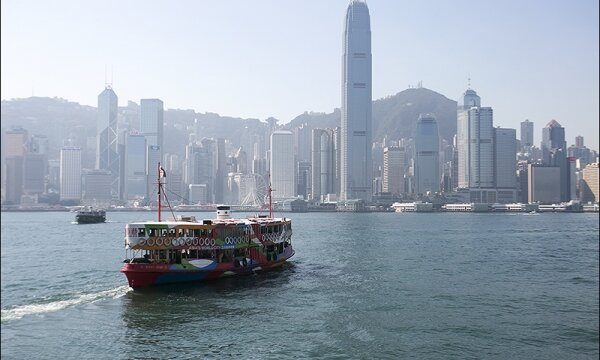
This is the route of our New Year's cruise: Singapore - Malacca (Malaysia) - Penang (Malaysia) - Phuket (Thailand) - Thilawa (Myanmar) - Porto Malai (Malaysia) - Port Klang (Malaysia) - Singapore - Nathon (Thailand) - Laem Chabang (Thailand) - Sihanoukville (Cambodia...
